Both the Indonesian and Japan tsunamis claim to be 100′ and 130′ high but all the video shows is some water rushing over the beach.
Where are the big waves they talk about?
Excellent question which is a pet peeve of mine. Tsunamis are often incorrectly depicted in popular media like this:
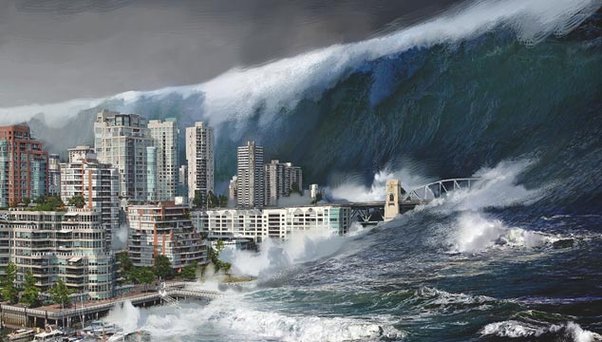
The reality is nothing like the above but is more like this (to begin with):

OK, so where is the 100 foot wave in the above? There isn’t one.
Instead when they say a tsunami goes to 100 or 130 feet (or whatever) what they are talking about is something called “run-up”, ie the maximum height above sea level the tsunami rises up to on land. Run-up can vary from place to place where a tsunami hits. It depends on a lot of factors like the power of the tsunami and coastal geography.
Run-up is caused by the rise of the sea level itself. Tsunamis are like the sea level suddenly rising. All that water now wants to flow downhill onto formerly dry land, and it develops considerable horizontal momentum as it moves forward. That forward momentum pushes the water in front higher and higher in spite of gravity until the leading edge of the tsunami gets so high that forward momentum can no longer overcome the pressure of the water raised to that height. That maximum height is “run-up”, and that is the height which is reported.
Once that maximum height — the run-up — is reached then the forward motion of the water ceases and it starts flow out again. This flow and ebb can occur several times, and the first one is not necessarily the strongest.
You can see run-up most clearly in the narrow, mountainous, river valleys which are so common on the coast of Japan where geography allows the forward momentum to be translated into water height most efficiently. Here is a series of three frames from a video shot in just such a place. The person taking the video had to keep climbing higher to stay out of the rising water. Watch the squarish blue building; it is made of strong stuff and survives the flood . . . .
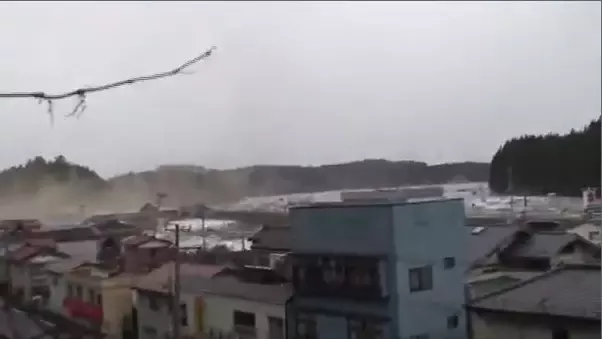
You can see above that the blue building is still high and dry, but the waters are rising in the distance.
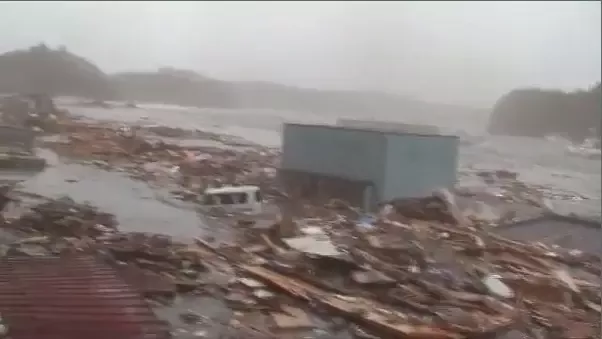
Now the blue building is being gutted by the rising water but it is somehow still standing even as smashed buildings float by. Its former neighbors are mostly gone.
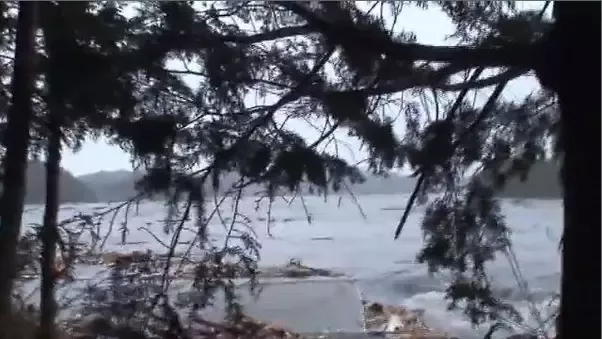
And now the blue building is covered by the water tho there is still an eddy showing where it is proving it is still standing even tho totally submerged. Another house is floating by too.
Max run-up is soon to be reached, tho, and then the water will start to flow out just as fast and destructively as it came in, tho I’d bet there is not much left to be destroyed at this point.
So when they say a tsunami reached, say, 100 feet then they are talking about water height above sea level as in the photos above, and NOT about the size of a wave at the beach. And, yes, run-up really can get that high or higher depending on circumstances.
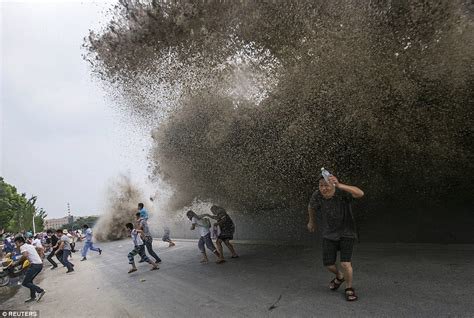
Low tide:
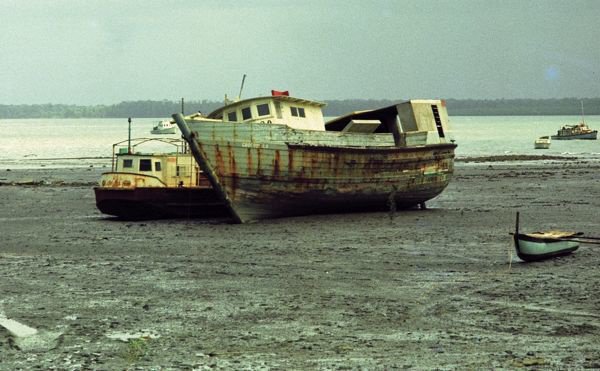
Waves and high seas are normally driven mainly by storms, winds and currents: air movement and surface currents, and affect only the surface of the ocean. Deeper down, it’s much calmer. (ask a submariner.)
As another answer points out, a tsunami often occurs when there is a sudden drop or collapse in the sea bed at one point usually associated with an earth quake or underwater cliff collapse. It could mass more than a mountain on land. The entire mass of water from the deep to the surface can be seriously disturbed for miles and it starts to move.
It is this very large volume of displaced water which is dangerous. This would trouble even a submarine. When this volume reaches the shore in a place where the seabed rises and the water shallows, that mass of moving water will become much higher.
Fairly obviously, the seabed rises and the water shallows at beach fronts or coastlines especially at islands gradually rising from deep ocean. (This is why islands are often badly affected by tsunamis.)
The ensuing wave height is the result of the mass of water, the narrowness of a coastal “bottleneck”, and the shallowness of the water/rise of the sea floor at that point. If the moving mass of water is further constricted in any way the resultant ‘waves’ can be very high indeed.
It is a function of geology and the geography of the coastal shape.
What many people don’t realise is that a ‘tidal’ wave or tsunami is neither impressive nor dangerous in mid ocean – it’s just moving water.
Even a massive tsunami event may only cause a ripple 6 inches to 1 or two feet high in mid ocean. This may be the only sign that a truly huge mass of water is moving rapidly across a very wide front. ‘Natural’ swells and waves can be much faster and higher/larger. Dangerous large ‘Freak’ waves can also occur. But these do not involve the same massive volume of moving water, being confined largely to the surface.
When a tsunami reaches a bottleneck at a rapidly shallowing shore and/or narrowing coastal feature, the huge mass of water is constricted and rises significantly. It is effectively under pressure as it is squeezed into the constriction. (This is obviously why a small water pistol can shoot 20 feet through a tiny hole pushed by a larger piston.)
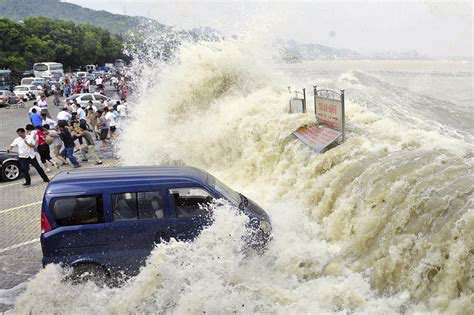
The term ‘tidal’ wave, often misused for a tsunami, is more correctly given to a wave which occurs naturally in some rivers and which behaves similarly. This is a ‘Tidal bore’.
These occur in rivers which lead to the sea. Specifically rivers which have a wider sea mouth and which narrow and shallow as they move further inland. In northern Australia for example, a 20 foot tide is not unusual in some rivers.
This can easily be seen in the amusing sight of small boats which are tied up to river piers. Inexperienced people tie boats up when the tide is high and many hours later when the tide has gone out, the boat is hanging out of the water, 12 feet above the river, secured by a short bit of line. (Experienced boaties use a very long line to allow for this movement.)
The misunderstanding in names has come about because of the behaviour of the water in these strongly tidal rivers. When a 20 foot tide comes up a narrowing, shallowing river (at perhaps metres/second) there is a huge wall of water heading up river sweeping all before it. A true ‘Tidal’ wave. You don’t want to be on the river while that’s happening..
As with other terrestrial cataclysms, such as volcanic eruptions and earthquakes, not all tsunamis are the same in magnitude. Movies sensationalise for entertainment purposes. But, in some places, a major tsunami might well cause a 100ft frontal wave and be devastatingly dangerous.
Low tide:
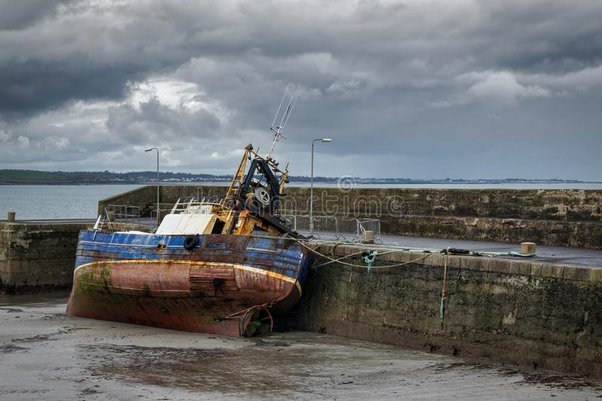
Related images from Google.
Because there are evidences.
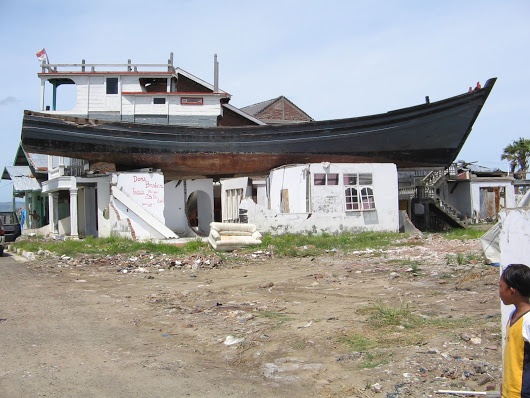
The ship didn’t walk and climb the houses. No. The wave put it there. Do you think water as high as the house can put the ship there? Surely not. Not high enough. It should have been much higher.
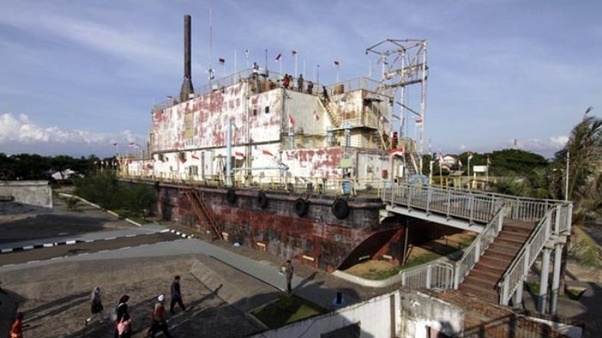
And this ship, was put where it is now by tsunami wave. This is 2 km from nearest shore.
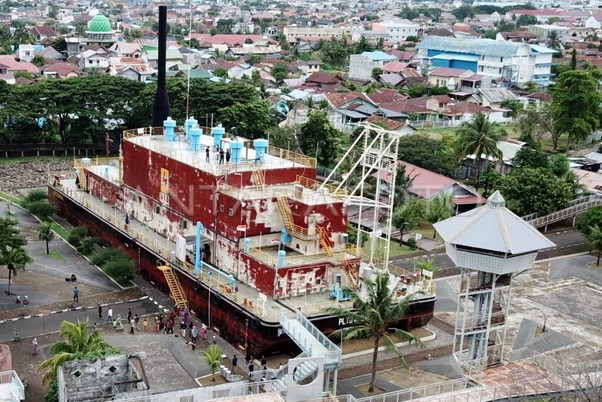
How did it get there? It was the water. Can you imagine how much water coming into the land to be able to put this ship 2 km inside?
You cannot imagine like something in the Hollywood movie. They are unrealistic.






